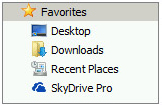2. SkyDrive Pro
A user’s personal site includes the SkyDrive Pro site and the Sites website, which were shown previously in Figure 4 and Figure 5, respectively. SDP is different from the SkyDrive functionality available from http://skydrive.live.com, the consumer file storage and sharing repository:
1. Users can
utilize both SkyDrive and SDP, but they should check their
organization’s corporate policy for the SkyDrive utilization because
that information is stored in the cloud.
2. SDP is a
private file repository for the user’s documents. You could consider
SDP to reflect the evolution and consolidation of the old “Personal
Documents” and “Shared Documents” libraries in SharePoint 2010. A
single folder appears in the library upon provisioning, which is called
Shared With Everyone (the people icon indicates that it is shared). All
documents placed in this folder will be available to any authenticated
users.
3. SDP has 100MB storage quota by default, but this is configurable by the administrator.
4. Documents
can be uploaded to the SDP library, and the library supports
drag-and-drop from the desktop. The following browsers support
drag-and-drop. In order for IE8 and IE9 to work, Office 2013 has to be
installed on the desktop. This list may be modified and updated over
time:
- Internet Explorer 10
- Internet Explorer 9 with Office 2013 installed
- Internet Explorer 8 with Office 2013 installed
- Firefox latest version
- Chrome latest version
5. Document viewing has been dramatically simplified. Figure 8 shows the preview window of a private Word document. To preview any
document in the SDP library, just click the ellipsis (...) next to the
name and it will open the preview window. If you have the Office Web
App server installed and configured you will see a preview of the Word
document. This preview capability is available with any SharePoint
document library, not just the SDP library. Note that you can edit the
document, share the document with others, and follow the document from
the preview window.
6. Document sharing, shown in Figure 9,
has also been simplified. In the sharing dialog window, type the name
of a colleague in your organization and specify whether you want the
person to view or edit the document; when you are finished, the person
will receive an e-mail message by default, indicating that you have
shared a document with them.
7. Documents
can be taken offline and synchronized with the copy inside the SDP
library. This is accomplished by clicking the SYNC button in the
upper-right corner, and the dialog shown in Figure 10
will be displayed. Note that you can change the location where
documents will be stored on the desktop. After clicking the Sync Now
button, you should receive an acknowledgment that the documents are
syncing, as shown in Figure 11. Figure 12 shows the new SDP folder added to your favorites in Windows Explorer.
FIGURE 12

8. The maximum number of documents you can synchronize is 20,000 and 5,000 for SDP and team site libraries, respectively.
9. One more thing to note. Click the Site Contents link to display the page shown in Figure 13. Note that two different lists support the social features, the Social list and the MicroFeed list.
That completes our brief tour of SDP, which is an important addition to the SharePoint 2013 toolset.